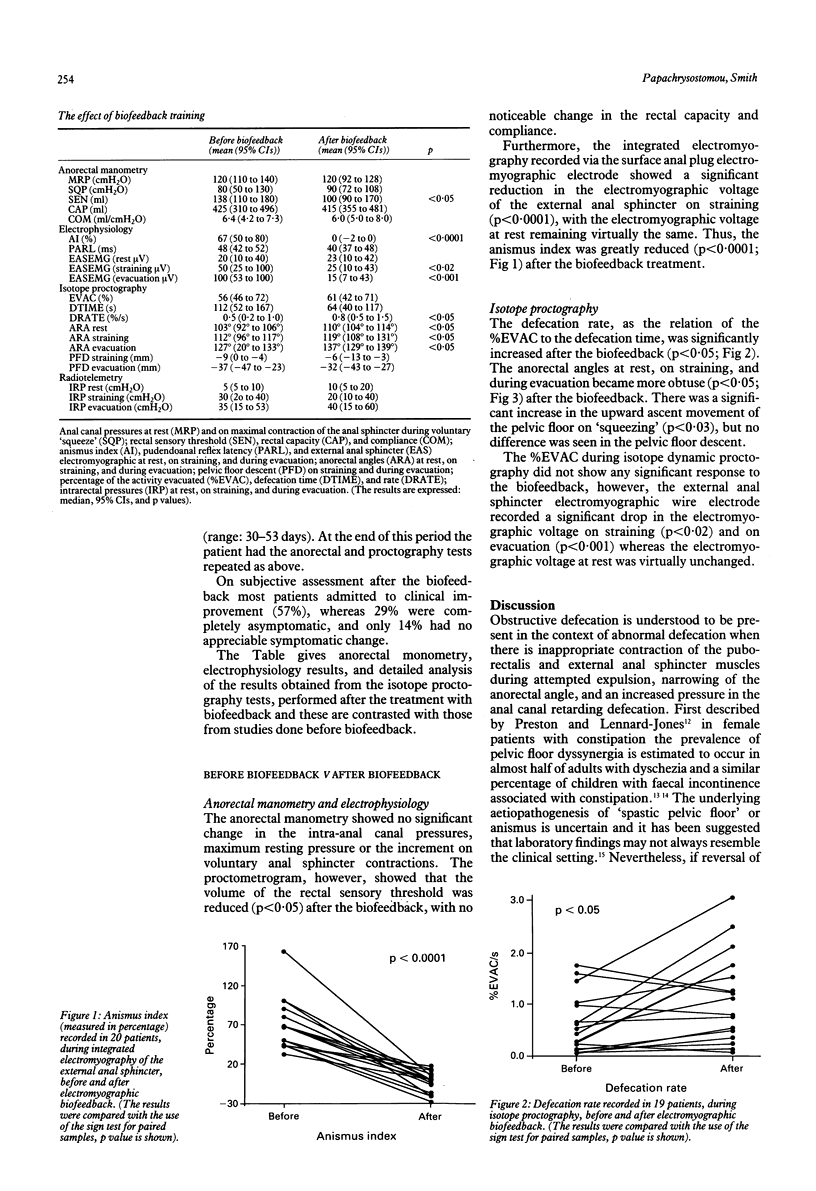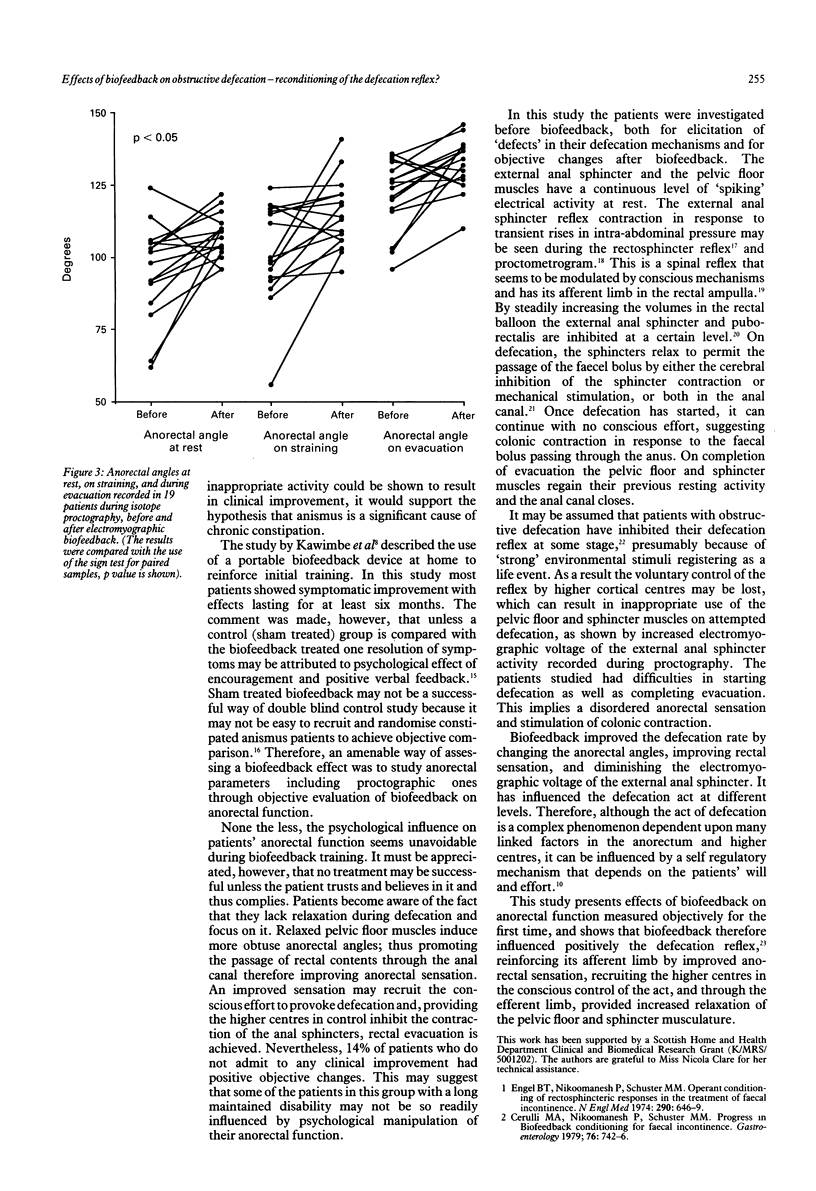Abstract
Twenty two patients with obstructive defecation were recruited for relaxation training by domiciliary self regulatory biofeedback. Each patient served as his or her own control for anorectal and proctographic assessments. Biofeedback training improved the obstructive symptoms of the patients and showed significant change in various parameters related to the obstructive defecation syndrome. As examined by isotope dynamic proctography: the defecation rate (% of evacuation/defecation time) was significantly increased (p < 0.05), the anorectal angles at rest and during attempted defecation were made more obtuse (p < 0.05), and the pelvic floor movements were made more dynamic on voluntary contraction of the anal sphincter (p < 0.03). The external anal sphincter electromyographic voltage recorded during defecation was significantly reduced (p < 0.0005) as was the surface anal plug electromyographic electrode voltage (p < 0.0001), which was associated with a greatly reduced anismus index (p < 0.0001). The rectal sensation was improved (p < 0.05), concomitantly. Biofeedback thus improves the defecation act in patients suffering from inappropriate contraction of the pelvic floor and sphincter musculature. Furthermore, this study has shown that biofeedback objectively influences the defecation reflex leading to an improved quality of higher control of bowel function.
Full text
PDF




Selected References
These references are in PubMed. This may not be the complete list of references from this article.
- Arhan P., Devroede G., Danis K., Dornic C., Faverdin C., Persoz B., Pellerin D. Viscoelastic properties of the rectal wall in Hirschsprung's disease. J Clin Invest. 1978 Jul;62(1):82–87. doi: 10.1172/JCI109117. [DOI] [PMC free article] [PubMed] [Google Scholar]
- Bleijenberg G., Kuijpers H. C. Treatment of the spastic pelvic floor syndrome with biofeedback. Dis Colon Rectum. 1987 Feb;30(2):108–111. doi: 10.1007/BF02554946. [DOI] [PubMed] [Google Scholar]
- Cerulli M. A., Nikoomanesh P., Schuster M. M. Progress in biofeedback conditioning for fecal incontinence. Gastroenterology. 1979 Apr;76(4):742–746. [PubMed] [Google Scholar]
- Constantinides C. G., Cywes S. Fecal incontinence: a simple pneumatic device for home biofeedback training. J Pediatr Surg. 1983 Jun;18(3):276–277. doi: 10.1016/s0022-3468(83)80099-2. [DOI] [PubMed] [Google Scholar]
- Duthie H. L. Dynamics of the rectum and anus. Clin Gastroenterol. 1975 Sep;4(3):467–477. [PubMed] [Google Scholar]
- Engel B. T., Nikoomanesh P., Schuster M. M. Operant conditioning of rectosphincteric responses in the treatment of fecal incontinence. N Engl J Med. 1974 Mar 21;290(12):646–649. doi: 10.1056/NEJM197403212901202. [DOI] [PubMed] [Google Scholar]
- Kawimbe B. M., Papachrysostomou M., Binnie N. R., Clare N., Smith A. N. Outlet obstruction constipation (anismus) managed by biofeedback. Gut. 1991 Oct;32(10):1175–1179. doi: 10.1136/gut.32.10.1175. [DOI] [PMC free article] [PubMed] [Google Scholar]
- Kock N. G., Kewenter J., Sundin T. Studies on the defecation relfex in man. Scand J Gastroenterol. 1972;7(8):689–693. doi: 10.3109/00365527209180978. [DOI] [PubMed] [Google Scholar]
- Loening-Baucke V. Modulation of abnormal defecation dynamics by biofeedback treatment in chronically constipated children with encopresis. J Pediatr. 1990 Feb;116(2):214–222. doi: 10.1016/s0022-3476(05)82877-x. [DOI] [PubMed] [Google Scholar]
- Merkel I. S., Wald A. Training for straining: biofeedback for pelvic floor dyssynergia. Am J Gastroenterol. 1992 Sep;87(9):1223–1224. [PubMed] [Google Scholar]
- Miller R., Duthie G. S., Bartolo D. C., Roe A. M., Locke-Edmunds J., Mortensen N. J. Anismus in patients with normal and slow transit constipation. Br J Surg. 1991 Jun;78(6):690–692. doi: 10.1002/bjs.1800780619. [DOI] [PMC free article] [PubMed] [Google Scholar]
- PARKS A. G., PORTER N. H., MELZAK J. Experimental study of the reflex mechanism controlling the muscle of the pelvic floor. Dis Colon Rectum. 1962 Nov-Dec;5:407–414. doi: 10.1007/BF02616644. [DOI] [PubMed] [Google Scholar]
- Papachrysostomou M., Griffin T. M., Ferrington C., Merrick M. V., Smith A. N. A method of computerised isotope dynamic proctography. Eur J Nucl Med. 1992;19(6):431–435. doi: 10.1007/BF00177370. [DOI] [PubMed] [Google Scholar]
- Preston D. M., Lennard-Jones J. E. Anismus in chronic constipation. Dig Dis Sci. 1985 May;30(5):413–418. doi: 10.1007/BF01318172. [DOI] [PubMed] [Google Scholar]
- Smith L. E. Biofeedback in anismus: the truth be known? Am J Gastroenterol. 1992 Aug;87(8):1058–1058. [PubMed] [Google Scholar]
- Turnbull G. K., Ritvo P. G. Anal sphincter biofeedback relaxation treatment for women with intractable constipation symptoms. Dis Colon Rectum. 1992 Jun;35(6):530–536. doi: 10.1007/BF02050531. [DOI] [PubMed] [Google Scholar]
- Varma J. S., Smith A. N. Reproducibility of the proctometrogram. Gut. 1986 Mar;27(3):288–292. doi: 10.1136/gut.27.3.288. [DOI] [PMC free article] [PubMed] [Google Scholar]
- Wald A., Hinds J. P., Caruana B. J. Psychological and physiological characteristics of patients with severe idiopathic constipation. Gastroenterology. 1989 Oct;97(4):932–937. doi: 10.1016/0016-5085(89)91500-x. [DOI] [PubMed] [Google Scholar]


